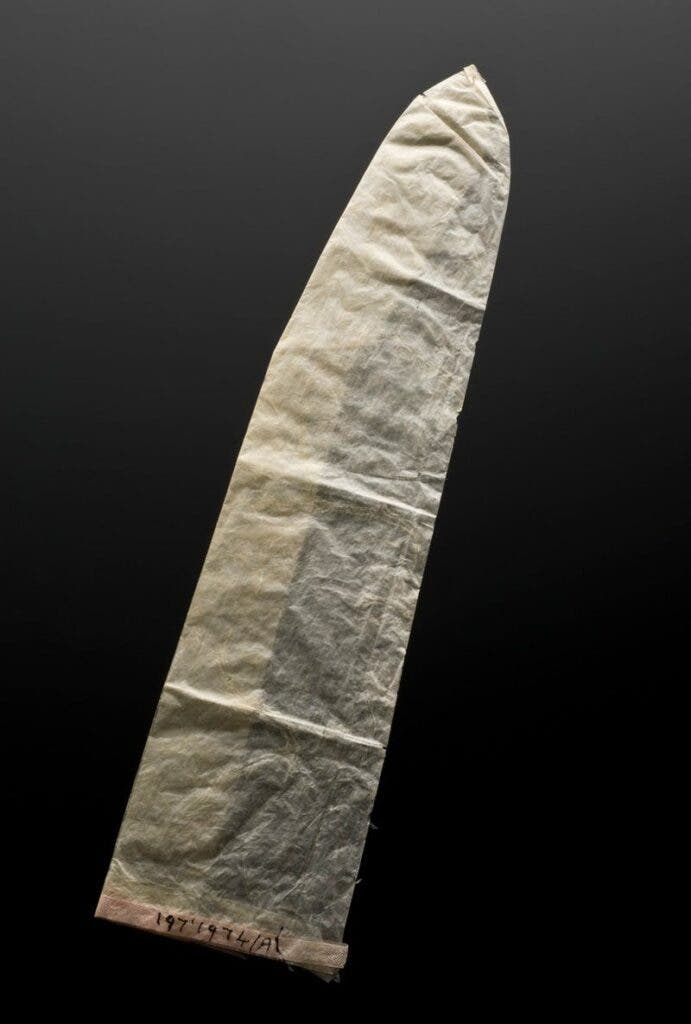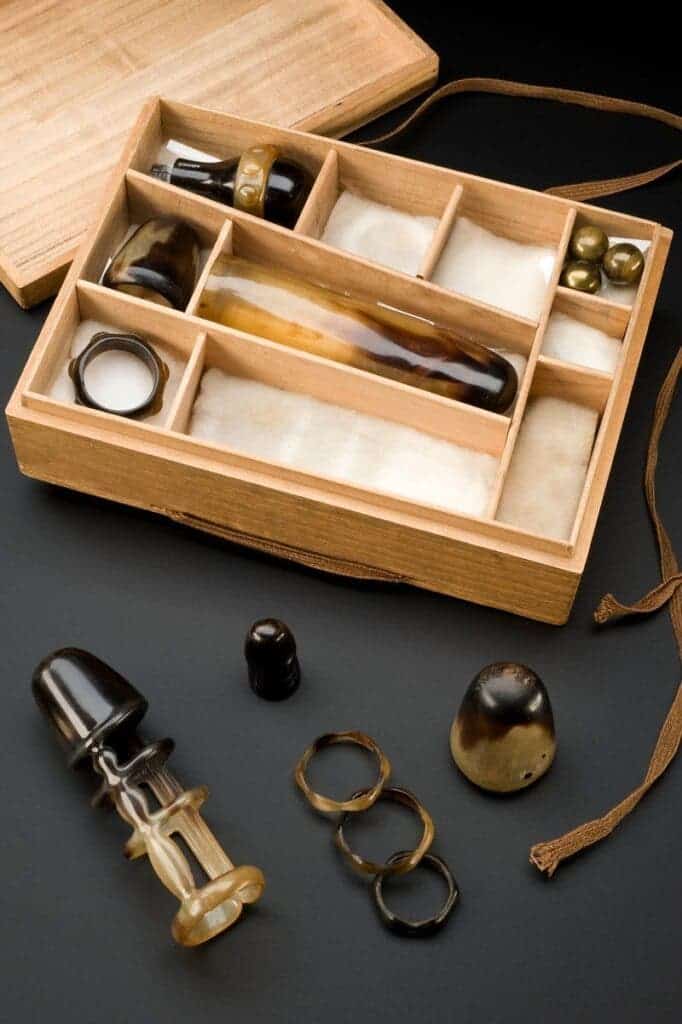Condoms have been around for thousands of years, but before the invention of vulcanized rubber in 1839, condoms looked (and felt) very different. From animal intestines, linen, and even tortoise shells, humans have tried many things in their quest for safe sex. Sometimes bizarre, sometimes innovative, condoms have played a significant role in our history. Let’s see what our ancestors worked with.

Divine punishment
The idea of safe sex is not a modern one. It’s not so much the idea of kids that our ancestors were most concerned about, but rather the fear of sexually transmitted diseases (STDs). Evidence such as clay tablets from Mesopotamia or papyri from Egypt shows that people have been aware of STDs since ancient times, although they were often inclined to chalk it up as a curse from the gods or some form of divine punishment.
The ancient Greeks, Romans, and Hebrews also describe genital diseases, as did Chinese and Indian physicians. During the Middle Ages, many physicians from around the world wrote on local genital diseases, describing them in great detail, but being remarkably far away from the truth when it came to the cause.
However, some were aware that sexual activity was at least somewhat connected to these diseases — and did their best to prevent transmission.
There is some speculation regarding some cave paintings from around 11,000 years ago, but there’s plenty of room for interpretation when it comes to that. However, at some point 5,000 years ago, some people were already using condoms. The first described usage of a condom comes from King Minos of Crete, a legendary king who, according to legend, was the son of Zeus. Minos, who may have been a historical figure as well (or at least based on one), is famous for hosting the Minotaur maze. But Minos was also said to have “scorpions and serpents” in his semen. The problem was so severe that, according to myth, it killed his mistresses.
So Minos’ wife employed a goat’s bladder and put it in her vagina so that King Minos’ dangerous seed would not harm her. Animal bladder was actually a preferred type of condom in the Roman Empire as well — or at least in some parts of it.
Meanwhile, ancient Egyptians used linen for theirs, which was dyed into different colors depending on their class — class distribution was complex but very important for the ancient Egyptians, and apparently, even condoms were not spared from distinctions. It’s not clear when this habit started, but evidence from about 1000 C.E. states that linen sheaths were not uncommon at the time.
However, the usage of condoms declined way before that, with the decline of the Roman Empire — like many other things. The Romans may have been fond of condoms (there’s even an unconfirmed rumor about them using the intestines of their fallen enemies as condoms), but much of the Roman-age writing on condoms has been lost (if there ever was any), so we don’t really know how widespread the usage of condoms was within the empire.
Middle Ages — nothing gets better

After the fall of the Roman Empire, Christianity started spreading, advocating the use of abstinence. That didn’t work, and STDs spread like wildfire. Throughout the Christian world, condom use was, as far as all evidence suggests, very low. Where it did happen, animal guts were the preferred condom material.
Aine Collier’s book The Humble Little Condom mentions several writings of Muslims and Jews on condoms (or other male contraceptives), and things did not improve. The writings include suggestions to cover the penis in tar or soak it in onion juice — things that not only wouldn’t work but were bound to be painful for all parties involved.
The same book mentions a comfier alternative used in China: oiled silk paper. It’s hard to say how effective it would have been, but at least it sounds a bit more appealing than animal intestines.
Meanwhile, the Japanese had a different idea. They were using something they called “Kabuta-Gata” to cover their glans. Kabuta-Gata was typically made from tortoise shell — although occasionally, it was made from leather.

Other cultures also developed their own ideas of the condom. For instance, the Djuka tribes that inhabited New Guinea developed a different type of condom: a sheath made from plants that were inserted into the vagina prior to intercourse. Apparently, the Djukas were also interested in avoiding conception, and the sheath was around six inches (15 cm) long.
…and then, syphilis
Things took a turn for the worse in 1494, when an outbreak of syphilis — the first well-documented one — decimated the French troops. The disease swept through Europe, as well as Asia, and wreaked havoc in China.
Syphilis isn’t as dangerous today as it was back in the day when, according to historian Jared Diamond, “its pustules often covered the body from the head to the knees, caused flesh to fall from people’s faces, and led to death within a few months.” Yeah, syphilis often led to death and was a dreadful disease, and people understandably wanted to avoid it.

We’re not sure when the disease emerged; it could be at some point during medieval times, it could be before that — at any rate, it was the French army that first experienced a notable epidemic. Unsurprisingly, it was called by the Italians (where it spread first) the “French Disease.” Unsurprisingly, the French didn’t like it, so they called it the “Spanish disease” — because the French army accused Spanish mercenaries of spreading the disease. The Russians called it the “Polish disease”, the Polish called it the “Turkish disease”, the Turkish called it the “Christian disease” and, well, you probably get the point by now. The emergence of syphilis is shrouded in mystery and finger-pointing.
But regardless of how it appeared, syphilis made quite an impact. Motivated in large part by it, 16th-century physician Gabriele Falloppio authored the earliest uncontested description of condom use. He called the book De Morbo Gallico (“The French Disease”), and in it, he recommended the use of a device he said he invented: a linen sheath soaked in some chemicals and dried before use. The device would cover the glans and was held by a ribbon. Falloppio, who also gave his name to the Fallopian tube, tested the device on 1100 men and claimed that none of them contracted syphilis, thanks to his invention.
Syphilis remained one of the most threatening diseases for the next 300 years. According to a 2020 study, over 20% of individuals in the age range 15–34 years in late 18th century London were treated for syphilis. But condom usage didn’t take off because it was still difficult, unpleasant, and inaccessible for many.
Until a major innovation took place in the 19th century, that is.

Here’s to modern condoms
Charles Goodyear wasn’t really thinking about sex when he made his breakthrough invention. A self-taught chemist, Goodyear invented vulcanized rubber, which allowed the transformation of rubber into more malleable structures. Goodyear first sold rubber gloves and tents, but it didn’t take long for him to realize that his new material could also be used for condoms.
Vulcanized rubber came in 1839, and by 1860, rubber condoms were produced on a large scale. They had several advantages — especially the fact that they were cheaper and could be reused with ease. Reportedly, the first condoms weren’t as comfortable as those made from intestines or bladder, but we couldn’t really find any reliable source on that. They were also more sturdy than the previous types.
Initially, rubber condoms only covered the glans of the penis, and a doctor measured each man and “prescribed” the correct size. But even with this, condoms would often slide down, so they were replaced by a complete sheath.
With time, rubber condoms became thinner and offered a more pleasant feel — in large part thanks to latex rubber. They were also lubricated (with petroleum jelly at first) and easily stored. The first ones were 2 millimeters thick, while today, many are under 0.6 millimeters.
Condoms today and in the future
So if you think you’ve got it rough because you need to wear a condom — tough luck! Our ancestors had to manage with animal intestines, tortoise shells, or linen. Even when rubber condoms emerged, they were far inferior to what we have access to today. Complain about it all you want, fellow men, but wearing a condom is still the best thing to do, not just to prevent STD transmission, but also to avoid a potentially life-changing unwanted conception.
Much of the stigma around condoms is owed to advertising and outright bans. It was only in 1965 that the US Supreme Court ruled that it was unconstitutional for the government to prohibit married couples from using birth control — and in the same year, 26 US states prohibited birth control for unmarried women. In socialist states, things were typically even worse, with all contraception being banned.
It was only in the 1980s that the use of condoms started taking off. But even then, many TV or radio networks banned condom advertising. The first condom ads didn’t air on primetime national TV until 2005. Religion also tends to be an adversary against contraception. Christian churches are staunch opponents of condoms, and only in the past few years has their opposition halfheartedly softened.

Condoms do work, though. In Ethiopia, where soldiers are required to carry a condom every time they leave base, the rate of HIV infection is about 5% — the lowest among African militaries.
Nowadays it’s estimated that over 5 billion condoms are sold worldwide every year, and potentially even more are given away. But over the past few decades, condoms have remained rather unchanged. Among those looking to change that is Bill Gates, who is investing in the next generation of condoms. From self-lubricating condoms to ones sprayed with medication that protects against STDs, the next generation of condoms is coming, and it’s about time.
From animal parts to modernized rubber, the humble condom has played an important role in human evolution, and will likely continue to do so for the foreseeable future. Civilizations have always tried to deal with problems like sexually transmitted diseases and birth control, and we’ve never had access to better tools.
So the next time you complain about having to put one on, be thankful instead. It could’ve been much worse.







